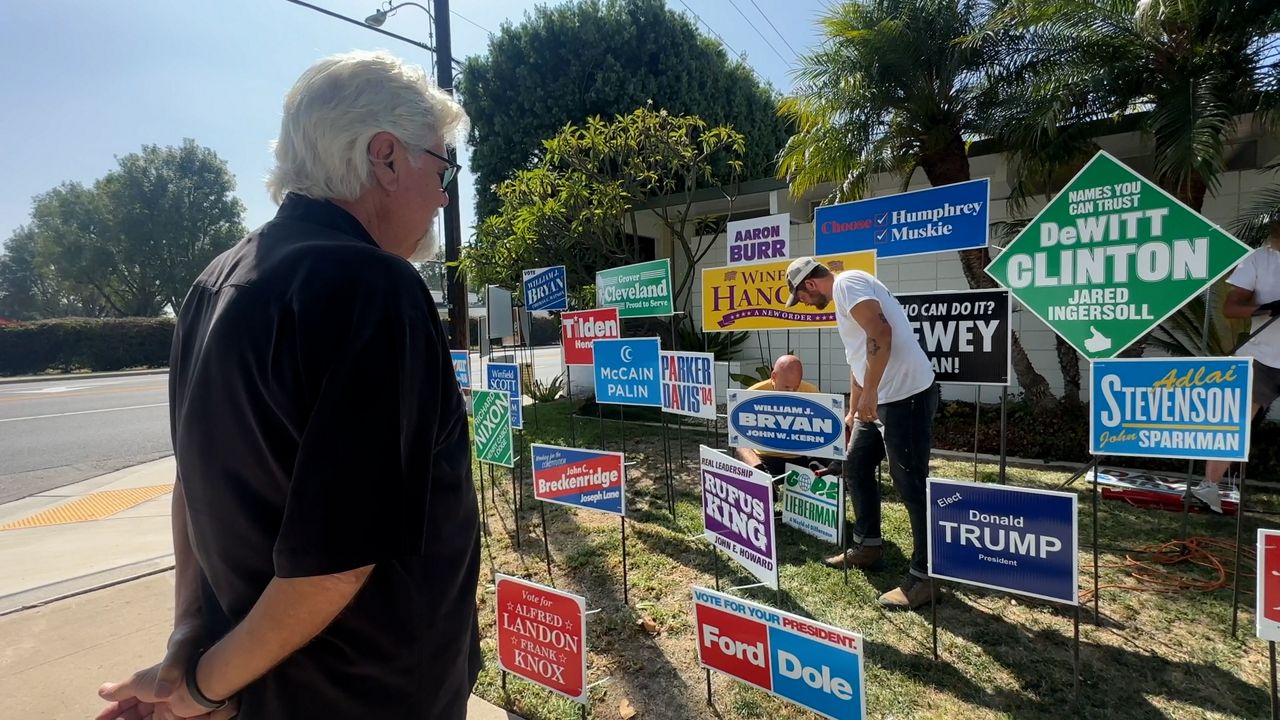ORANGE, Calif. — As the world watches to see who will be elected president in a few weeks, John Spiak is firmly rooted in the past as he helps install a political time machine.
“I love it,” he said with enthusiasm. “It’s a history lesson.”
Spiak is the director and chief curator at Cal State Fullerton’s Grand Central Art Center, although this particular exhibit finds him at the now very crowded and very colorful corner of Fairhaven and South Oakwood in Orange. It’s his second time installing artist Nina Katchadourian’s “Monument to the Unelected,” a sort of living exhibit that grows with each passing presidential political cycle.
“Always an interesting process in the United States,” Spiak said with a knowing smile.
It’s a process that goes back to the country’s founding, with half the cast of Hamilton represented on this lawn. Of course, Aaron Burr didn’t have lawn signs. Or Horace Greeley. Or even Spiak’s favorite example…Herbert Hoover.
“It says optimism and prohibition,” he pointed out. “I really feel like these things really conflict with one another.”
None of the signs were actually used by a campaign, even for modern races. The candidates and their running mates are real, but the artwork and slogans are the creation of Katchadourian and graphic designer Evan Gaffney. The exhibit is being housed on the lawn of Jon Webb, who also hosted it in 2020. The first race he remembers as a kid: Eisenhauer vs Stevenson in ‘56.
“I don’t know who Adlai Stevenson ran with,” he admitted, remembering his mother wearing campaign buttons at the time. A sign behind him held the answer — Senator Estes Kefauver — but in Webb’s defense, he was only seven years old at the time.
He knows emotions around elections are heightened but he wasn’t too worried about offering up his lawn because the exhibit, as the artist puts it, is a nonpartisan reminder of the road not taken as well as a reflection of a tradition that dates back to 1797 when Washington handed over the reigns to John Adams.
“This is about transfer of power, right?” Webb said. “It was always like, ‘Oh, I lost. You won. Congratulations. See you down the road.’ But now it’s an ongoing issue.”

Now before you think, well, that’s a direct commentary on the 2020 election, know that Katchadourian’s art installation began in 2008 (when McCain was initiated into this inauspicious club) and has grown to now include 59 signs of losing candidates. After this election a new sign will be added – number 60 — and Spiak is prepared for either outcome.
“We have two signs ready to go,” he explained. “So we have a Harris and we have a Trump one. And whichever individual loses, we’ll place that sign on the lawn.”
The exhibit, which is also being presented at six other locations across four states, will remain on the lawn through Nov. 17, although Spiak remembers last time having to extend it for a bit because of the delay in announcing a winner.
He sees this evolving installation as a great example of how artists can help us understand our own history, even as it’s being written.
“Nina’s allowing us a moment to think back and to reflect, and to do it in a fun way,” he said. “It’s on someone’s lawn and it’s a public setting. You don’t have to pay to go to a museum. It’s free art sitting here in the public.”
Free public art. Doesn’t get more democratic than that.



